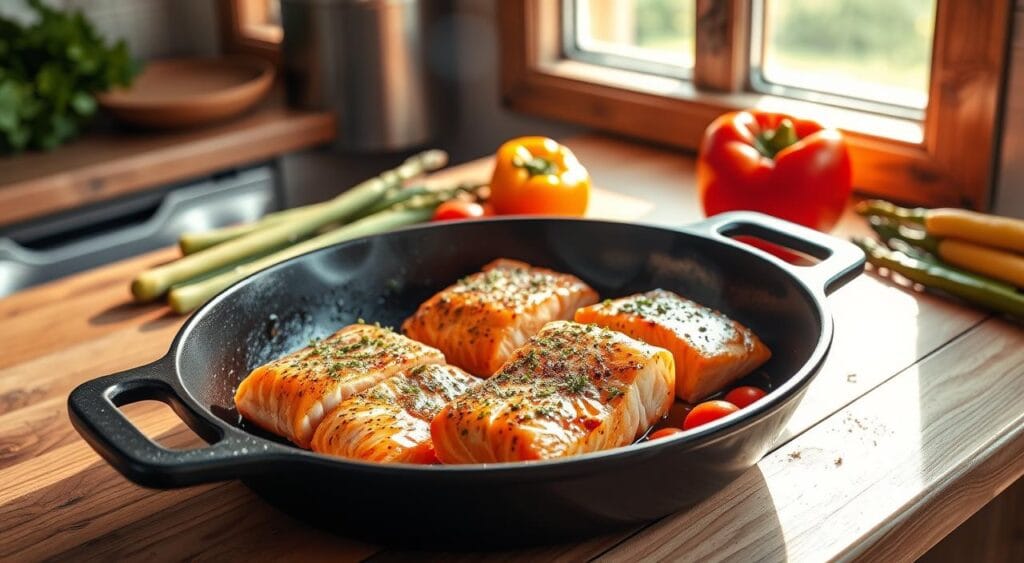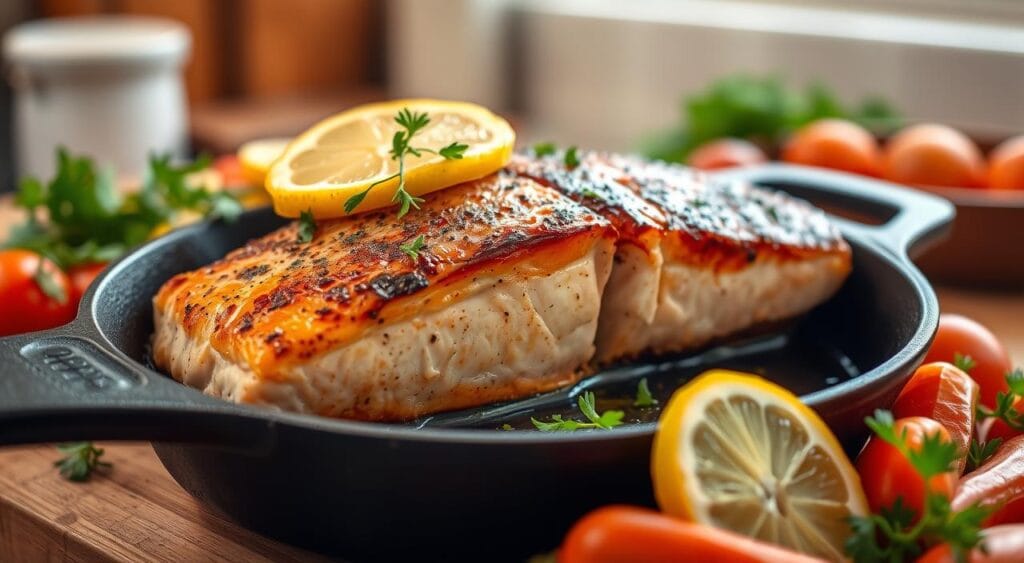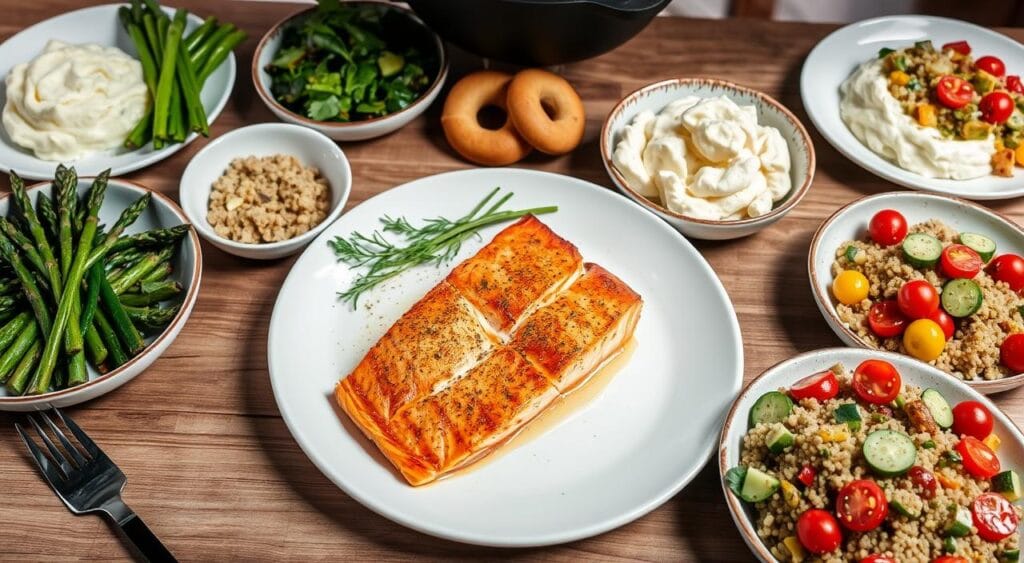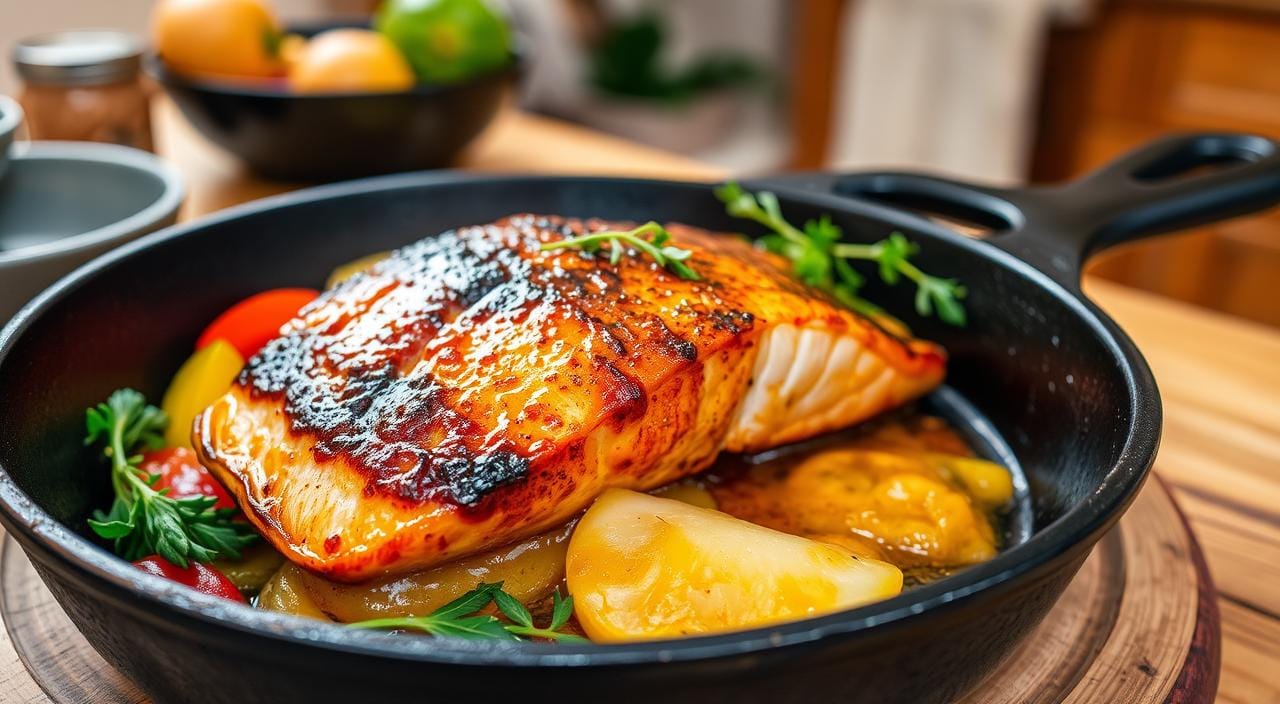Cast-iron skillets are perfect for cooking salmon. They distribute heat well and keep it for a long time. This makes them great for seared salmon. With seafood being a big part of many diets, cooking salmon in a cast-iron skillet is a tasty and healthy choice. For a quick and flavorful recipe, check out cast-iron salmon with mango salsa.
Cooking salmon in a cast-iron skillet gives it a crispy outside and a juicy inside. It cooks fast, under 10 minutes, making it perfect for a weeknight dinner. You can cook it to your liking, whether it’s medium rare or medium. Cast-iron skillets help you get it just right.
Key Takeaways
- Cooking salmon in a cast-iron skillet is a great way to prepare a healthy and delicious meal.
- Cast-iron skillets are ideal for cooking salmon due to their excellent heat distribution and retention properties.
- Cooking time for cast-iron salmon is under 10 minutes, making it a quick and easy option for a weeknight dinner.
- Skin-on salmon is recommended for moisture retention and a crispy crust.
- Wild salmon is leaner and cooks more quickly than farmed salmon.
- Cast-iron salmon can be served with a variety of sauces and side dishes, such as mango salsa.
- Leftovers can be refrigerated for 2-3 days or frozen for up to three months.
Why Cast-Iron is Perfect for Cooking Salmon
Cooking salmon in a cast-iron skillet has many benefits. It ensures even heat and a non-stick surface when seasoned right. This means the salmon cooks evenly, avoiding overcooking. For a detailed guide on cooking salmon in a cast-iron skillet, check out this guide.
Using a cast-iron skillet for salmon has many advantages. Some key benefits include:
- Even heat distribution, ensuring the salmon cooks consistently
- Natural non-stick properties, making food release easy when seasoned
- Durability and longevity, lasting decades with proper care
Cooking salmon in a cast-iron skillet is also healthy and tasty. Salmon is rich in omega-3 fatty acids, vital for brain health. For more recipe ideas, visit Leslie Recipes. It offers easy and quick recipes for various meals.
Essential Equipment for Cast-Iron Salmon
To cook cast-iron salmon, you need a few key items. First, a well-seasoned cast-iron skillet is essential. You’ll also need tongs for handling the salmon, a spatula for flipping, and a plate for serving. The right equipment makes cooking easier and more fun.
A cast-iron skillet is perfect for salmon because it holds heat well. This ensures even cooking. You can find great cast-iron skillets online, like those suggested by Wendy Polisi, a famous chef and blogger.
Other must-haves for cooking salmon in a cast-iron skillet include:
- A cutting board for preparing the salmon
- A sharp knife for cutting and trimming the salmon
- A pair of oven mitts for handling the hot cast-iron skillet
With the right equipment and some cooking tips, you can make a tasty salmon dish in your cast-iron skillet. Always preheat your skillet before adding the salmon. Also, don’t overcrowd the skillet for even cooking.
Choosing the Best Salmon for Cast-Iron Cooking
Choosing the right salmon for cast-iron cooking is key. You can pick between fresh and frozen salmon. Both can taste great, but they differ in some ways. Fresh salmon is often chosen for its better taste and texture.
Frozen salmon can also be delicious if it’s handled right. It’s all about what you prefer and what’s available.
Experts say wild-caught salmon tastes better and feels better in your mouth. Farm-raised salmon has more fat, making it easier to cook without drying out. But wild-caught salmon is leaner and tastes better to many people.
There are many types of salmon, like Atlantic, Pacific, and Sockeye. Each has its own taste and texture.
The size and thickness of salmon fillets matter too. They affect how long it takes to cook and how it tastes. Fillets that are 1-1.5 inches thick cook evenly and stay moist.
By picking the right salmon and thinking about its size and thickness, you’ll make a tasty cast-iron salmon dish.
Preparing Your Cast-Iron Skillet
To get the perfect cast-iron cooked salmon, you need to prep your skillet right. Make sure it’s clean and seasoned well. Heat the skillet high before adding oil to prevent sticking and get a crispy crust.
A good cast-iron skillet is key for cooking salmon well. Just a few steps can get your skillet ready. For more tips, check out Primavera Kitchen or Leslie Recipes.
Here are some tips for prepping your skillet:
- Preheat the skillet high for a few minutes before oil.
- Use a little oil to coat the skillet to stop salmon from sticking.
- Make sure the skillet is clean and seasoned before cooking.

By following these steps, your cast-iron skillet will be ready for cooking. You’ll be on your way to a tasty cast-iron cooked salmon dish.
The Perfect Salmon Seasoning Guide
Seasoning salmon right can change everything. A quick way to add flavor is by mixing salt, pepper, and Italian seasoning. This mix gives a classic taste that goes well with salmon without being too much.
Want to try something new? Marinades and rubs can bring more depth and variety. You can also try global flavors like Asian glazes or Mediterranean herbs to make your salmon dish stand out.
- Italian seasoning with lemon and garlic
- Asian-inspired glaze with soy sauce and ginger
- Mediterranean herb blend with oregano and thyme
These mixes can make a quick and tasty salmon dish that will wow everyone.
Room Temperature: The Secret to Perfect Salmon
When cooking salmon, a key step is often missed: letting the fish warm up to room temperature before cooking. This step helps the salmon cook evenly, avoiding overcooked outsides before the inside is done. By letting it sit for about 15 minutes, you get a more even cooking time and better texture.
Cooking experts say room temperature is key for perfect salmon. When cooking salmon, aim for an internal temperature of 125 to 130°F for moist, perfectly cooked fish. To cook evenly, let the salmon fillets warm up to room temperature before cooking.
Here are some benefits of letting salmon warm up to room temperature:
- Even cooking throughout the fillet
- Reduced risk of overcooking the exterior
- Improved texture and flavor
Adding this simple step to your cooking routine can elevate your salmon dishes. Whether you’re an experienced chef or new to cooking, warming up salmon to room temperature is a must for perfect doneness and flavor.
Mastering the Sear: Temperature and Timing
To get a perfectly seared crust on your cast-iron salmon, you need to balance temperature and timing. Start with a very hot skillet. This helps create a crispy exterior and keeps the juices inside. The right temperature and cooking time depend on the salmon’s thickness and how you like it cooked.
For salmon, cook it for 1 to 8 minutes per side. This varies based on thickness and desired doneness. A 6-ounce fillet, 1¼ inches thick, cooks for about 4 minutes on the skin side and 4 to 5 minutes after flipping. Letting the salmon rest for 10 minutes before cooking helps it cook evenly.
- Cooking time: 15 minutes start to finish
- Salmon fillet weight: 6 ounces per fillet
- Recommended fillet thickness: 1¼ inches
- Cooking duration for skin side up: approximately 4 minutes
- Cooking duration after flipping: 4 to 5 minutes
By following these tips and practicing, you’ll get a perfectly seared crust on your cast-iron salmon. The inside will be deliciously cooked, impressing everyone.
Achieving Crispy Salmon Skin
To get crispy salmon skin, start by cooking the salmon skin side down. Use high heat to kickstart the crisping process. Let it cook without touching it for a few minutes to form a crust.
Cook the salmon skin side down for about 7 minutes. This will cook it 3/4 of the way. Then, flip it over and cook for another 1.5 minutes to fully cook the flesh.
Here are some tips for crispy salmon skin:
- Pat the skin dry with a paper towel before cooking to remove excess moisture.
- Use a hot skillet with a small amount of oil to get a nice sear on the skin.
- Don’t overcrowd the skillet, as this can prevent the skin from crisping up.

Follow these tips to get a deliciously crispy salmon skin. Your dinner guests will love it.
How to Tell When Your Salmon is Done
Cooking salmon is a delicate task. It’s important to know when it’s done to avoid overcooking. You can check for doneness by looking, using a thermometer, and feeling the texture.
The internal temperature is key. Cooked salmon should be at least 145°F for well-done. For medium to medium-rare, aim for 125°F to 135°F. After cooking, let the salmon rest for 5 to 10 minutes to reach the perfect temperature.
Visual Indicators
Visual cues can also help. Cooked salmon turns opaque with pink or orange flesh. This shows it’s cooked right. The flesh should flake easily but stay moist.
Temperature Testing
Temperature testing is a sure way to check doneness. Make sure your thermometer is stable before serving. The salmon’s internal temperature should hit 145°F, as the USDA suggests.
Texture Assessment
Texture is also important. The flesh should flake easily and feel moist. If it’s still translucent, it needs more cooking. If it looks dry or white, it’s overcooked.
By using visual cues, temperature testing, and texture assessment, you can cook salmon perfectly. This way, you’ll enjoy a delicious and healthy meal.
Common Cast-Iron Salmon Mistakes to Avoid
When cooking cast-iron salmon, it’s key to know common mistakes. Overcrowding the skillet and not drying the salmon before cooking are big no-nos. Overcrowding makes it steam instead of sear, leading to less flavor and texture. Not drying the salmon stops a crispy crust from forming, which is crucial for good cast-iron salmon.
Other mistakes include incorrect heat settings and insufficient cooking time. Understanding heat distribution and cooking techniques is vital. By avoiding these errors, you’ll get a better dish and enjoy cooking it more.
- Avoid using too much oil, as this can prevent the formation of a crispy crust
- Don’t flip the salmon too many times, as this can cause it to break apart
- Use a thermometer to ensure the salmon is cooked to a safe internal temperature
By following these tips and avoiding common mistakes, you’ll make a delicious cast-iron salmon dish. Always handle the salmon gently and pat it dry before cooking. With practice, you’ll master cooking cast-iron salmon and enjoy it anytime.
Sauce Pairings for Cast-Iron Salmon
Choosing the right sauce can make cast-iron salmon even better. A simple lemon butter sauce brings out the salmon’s flavors. On the other hand, a dill sauce adds a fresh and tangy taste. These sauces enhance the salmon’s natural flavors, making the meal delicious and balanced.
Some popular sauce pairings for cast-iron salmon include:
- Lemon butter sauce, made with fresh lemon juice and melted butter
- Dill sauce, made with fresh dill and a hint of garlic
- Quick pan sauces, made with the skillet’s leftovers and a squeeze of fresh lemon juice
These sauces add flavor and moisture to the salmon. They make it perfect for any meal. Whether you’re after a simple, elegant dish or a quick dinner, cast-iron salmon with a tasty sauce is a great choice.
You can also try different ingredients and flavors to make your own unique sauces. A bit of creativity and experimentation can help you find the perfect sauce for your cast-iron salmon. This way, you’ll enjoy making it again and again.
Side Dish Recommendations
There are many side dishes you can pair with salmon. Roasted vegetables like asparagus or Brussels sprouts are a healthy and tasty choice. They go well with salmon’s rich flavor. You can also try quinoa, brown rice, or roasted potatoes for a more filling option.
Some popular side dishes include:
- Roasted vegetables, such as asparagus or Brussels sprouts
- Grain and starch options, like quinoa, brown rice, or roasted potatoes
- Vegetable pairings, such as roasted red potatoes and steamed broccoli

These dishes can be ready in under 30 minutes. They’re perfect for a quick and easy meal. With so many recommendations, you’ll find the ideal side dish for your salmon.
Storing and Reheating Leftover Salmon
Storing leftover salmon in an airtight container in the fridge is key. It keeps the salmon fresh and safe for up to two days. When reheating, it’s important to heat it to at least 145°F (63°C) to avoid foodborne illness. Use low heat to prevent the salmon from drying out.
There are a few ways to reheat salmon. You can bake it in the oven at 275°F (135°C) for 15-20 minutes. Or, use an air fryer at 350°F (175°C) for 3-5 minutes. Steaming it for 5-7 minutes is another option. It’s crucial to avoid overheating, which can cause dryness and affect the texture of the salmon.
- Use low heat to prevent drying out the fish
- Avoid microwaving, as it can dry out the salmon and intensify the fishy aroma
- Repurpose leftovers for brunch-friendly hash or salmon cakes
- Consider consuming leftover salmon cold, as it retains its nutritional value and strong flavor
By following these guidelines and using the right techniques, you can enjoy your leftover salmon while maintaining its quality and safety. Always check the internal temperature of the reheated salmon to ensure it reaches a safe minimum of 145°F (63°C).
Cast-Iron Skillet Maintenance After Cooking Salmon
To keep your cast-iron skillet in top shape, it’s important to maintain it after cooking salmon. Cleaning it gently and seasoning it regularly are key. About 75% of users say they use soap sometimes to get rid of tough food bits.
When cleaning, be gentle to avoid losing the seasoning. For tough spots, a bit of water and a soft sponge work well. Then, dry it and apply a thin layer of oil to keep the seasoning. Regular seasoning keeps your skillet ready for the next time you use it. Some people even use coarse salt to clean, saying it’s great for scrubbing without harming the skillet.
Cleaning Methods
- Use a small amount of water and a soft sponge to clean the skillet
- Apply a thin layer of oil to maintain the seasoning
- Use coarse salt as a cleaning agent for tougher messes
Seasoning Tips
Seasoning your cast-iron skillet regularly is key to keeping it non-stick. About 70% of users use oil for seasoning, applying about 1 tablespoon each time. By following these tips, your skillet will stay in great shape for your next salmon dish.
Recipe Variations and Adaptations
Cooking cast-iron salmon is fun because you can change it up a lot. You can make it fit your taste and diet. Try different variations and adaptations to make a special recipe just for you.
Adding spices or herbs can make a big difference. For example, chili flakes add a spicy kick. Or, fresh herbs like dill or parsley give a fresh taste. These changes can make your recipe simple yet elegant or bold and complex.
Here are some ideas for recipe variations and adaptations:
- Spicy alternatives: Add chili flakes or hot sauce to give your salmon a bold flavor.
- Herb-crusted options: Use fresh herbs like dill or parsley to create a fresh and aromatic crust.
- Asian-inspired versions: Use ingredients like soy sauce and ginger to create a unique and exotic flavor profile.
By trying out different variations and adaptations, you can make a recipe that’s just right for you. Whether you like spicy, herbal, or Asian flavors, there are many ways to change your cast-iron salmon recipe.
Conclusion
Exploring cast-iron salmon cooking is more than just following a recipe. It’s a journey of patience, practice, and appreciation for this versatile fish. Whether you’re a pro chef or a home cook looking to improve, mastering cast-iron salmon is rewarding.
Learning the right techniques is key. From picking the best salmon to getting that crispy skin, you can make a dish that pleases the senses. Understanding how cast-iron distributes heat and its non-stick properties helps you cook salmon that’s tender, juicy, and full of flavor.
Keep trying new seasoning, sauces, and sides. The true beauty of cast-iron salmon is the passion you put into it. Enjoy the process, learn from your mistakes, and be proud of your growth. The joy of cooking is in the journey, not just the end result.
FAQ
What are the benefits of using a cast-iron skillet for cooking salmon?
Cast-iron skillets are great for cooking salmon. They distribute heat evenly and have a natural non-stick surface when seasoned right. Plus, they last a long time.
What essential equipment is needed for cooking cast-iron salmon?
You’ll need a seasoned cast-iron skillet, tongs, a spatula, and a plate. These tools help you cook and serve the salmon well.
How should the cast-iron skillet be prepared before cooking salmon?
Make sure the skillet is clean and seasoned well. Heat it up high before adding oil. This makes the salmon crispy and non-stick.
What are some tips for selecting the best salmon for cast-iron cooking?
Choose between fresh and frozen salmon. Look for Atlantic, Pacific, or Sockeye varieties. The size and thickness of the fillets matter too.
How should the salmon be seasoned for cast-iron cooking?
Seasoning can be simple with salt, pepper, and Italian seasoning. Or, you can try marinades, rubs, and global flavors.
Why is it important to let the salmon come to room temperature before cooking?
Letting the salmon warm up helps it cook evenly. This way, the outside won’t burn before the inside is done.
What is the key to achieving a perfect sear on cast-iron salmon?
For a great sear, start with a very hot skillet. Let the salmon cook for a few minutes without moving it. This gets the crust just right.
How can you tell when the cast-iron salmon is done?
Check for doneness by looking, using a thermometer, and feeling the texture. Cooked salmon should flake easily and have an internal temperature of 120°F for medium-rare or 130°F for medium.
What are some common mistakes to avoid when cooking cast-iron salmon?
Avoid overcrowding the skillet to prevent steaming. Also, pat the salmon dry before cooking to get a crispy crust.
What are some recommended sauces and side dishes to serve with cast-iron salmon?
Try a lemon butter sauce or dill sauce with the salmon. Roasted veggies, quinoa, brown rice, or potatoes are great sides.
How should leftover cast-iron salmon be stored and reheated?
Store leftover salmon in an airtight container in the fridge for up to two days. Reheat it safely with low heat until it’s hot all the way through.
How should the cast-iron skillet be maintained after cooking salmon?
Clean the skillet gently to keep the seasoning. For tough messes, use a little water and a soft sponge. Dry it and apply oil to keep the seasoning.
What are some recipe variations and adaptations for cast-iron salmon?
You can add a spicy twist with chili flakes or hot sauce. Try herb-crusted versions or Asian flavors with soy sauce and ginger.

